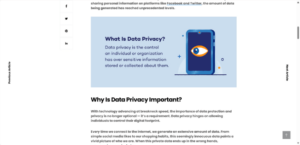Ensuring internet security is essential for every organisation, as the web browser serves as the primary gateway for users to access online content, including potentially harmful material. Consequently, securing browsers is crucial, with privacy being a vital aspect of this security. Major browsers like Chrome and Edge, along with Safari to a lesser degree, are developed by companies that monetise user data by selling it to advertisers and other external entities. Furthermore, these browsers retain sensitive information such as passwords and usernames—data that can attract hackers despite being encrypted.

Much of this sensitive information is stored in cookies, while users’ preferred websites are logged in their browsing history—data that browser companies may also exploit commercially. To mitigate these risks, organisations often choose to turn off features like autocomplete for usernames and passwords or regularly clear cookies. However, this approach means users must manually input their credentials each time they visit a site requiring login information.
Despite the necessity of prioritising security and privacy, it should not come at the expense of user experience (UX). Browsers incorporate various features designed to enhance both privacy and security; however, achieving absolute protection from all potential threats—including adware—is virtually impossible. Every member of an organisation needs to utilise a secure browser regardless of whether they handle sensitive financial or classified data.

To effectively address browser security threats within an organisation, it’s advisable to start by identifying the specific risks they face. While existing threat assessments cover numerous contemporary attack vectors, new strategies may emerge over time. Therefore, IT teams need to stay updated on any recent browser security enhancements. With this knowledge in hand, they can evaluate which browsers are most suitable for their needs and identify additional tools necessary to bolster safe web browsing practices across the enterprise.
One of the primary challenges organisations face in cybersecurity is the threat of phishing. These attacks are particularly potent, often serving as gateways to more severe cybercrimes like advanced persistent threats and ransomware. Phishing schemes typically deceive individuals into clicking on links that lead to compromised websites, where they may unwittingly provide sensitive information such as passwords, personal details, or financial data. A single unsuspecting user who downloads malware hidden within a game, video, or other file can open the door for hackers to infiltrate an organisation’s network. To combat these risks effectively, businesses must strike a balance between implementing robust, acceptable use policies and deploying appropriate technological safeguards throughout their operations.

According to a report from Cisco, the four most common security threats are cryptomining, phishing, Trojans, and ransomware—together generating around 100 million threats each month. In contrast, all other types of threats contribute only a fraction of that total. The study revealed that 86% of surveyed organisations experienced at least one incident where a user attempted to access a phishing site; additionally, 70% reported users encountering malicious browser ads. Alarmingly, Cisco estimated that around 90% of data breaches originate from phishing attacks. This highlights the necessity for companies to prioritise phishing prevention within their overall security strategy while also ensuring compatibility with browser security measures.
While phishing usually begins with an email link leading to a fraudulent website, choosing the right web browser is crucial due to its antiphishing capabilities. IT teams must also be vigilant against various other threats: redirects that mislead users into visiting harmful sites by employing deceptive tactics or fake interfaces resembling legitimate ones; intrusive pop-up ads that cannot be dismissed or overwhelm users during legitimate browsing activities; vulnerabilities stemming from operating system or browser security lapses; plugins and extensions sourced from unreliable or counterfeit providers; potential leaks from stored passwords in browsers; and accessible browser history and cache that can be exploited for tracking purposes.

When it comes to reducing browser attacks, one of the most crucial steps that IT teams can take is to focus on educating end-users. No matter how sophisticated security technologies are, they cannot fully safeguard an organisation if users inadvertently compromise security by engaging with threats. Many companies have instituted annual training sessions aimed at helping employees recognise phishing attempts and other browser-related attacks, which often extend to cover various forms of social engineering as well. Such educational initiatives tend to yield more effective results than implementing strict browser usage policies or investing heavily in complicated security systems.
Nonetheless, specific tools and software solutions can enhance security measures. For instance, pop-up blockers can be helpful. They primarily aim to eliminate unwanted advertisements and inadvertently block pop-ups that require user input, such as login credentials or form submissions. However, hackers have found ways to circumvent many of these blockers, which means this technology may be addressing an outdated issue rather than providing a robust defence against modern threats.
IT teams can also strengthen the inherent security of operating systems and browsers through a proactive patch management strategy. Although vendors promptly release patches for viruses and vulnerabilities, these threats often infiltrate systems before updates are applied. Therefore, timely patching is critical for maintaining a secure environment for end-users.
Antivirus software represents another layer of protection by offering features such as adware removal and password management—often proving more effective than the built-in capabilities found in browsers. Notably, some antivirus programs also include pop-up blocking functionalities.

Content blockers serve as valuable tools in the fight against phishing attacks by preventing harmful information from being displayed on users’ screens. IT departments can typically implement these content blockers through browser extensions like uBlock Origin, which filter out ads and tracking scripts while maintaining an updated list of malicious URLs. Additionally, using website blocklists and allowlists helps further refine what content is accessible to users.
Lastly, browsers provide options for personal website blocking, which empowers users to take control over their online experiences by restricting access to specific sites deemed unsafe or inappropriate.
When it comes to managing personal websites, browsers offer users the flexibility to add or remove specific sites from their accessible lists. This capability allows IT and business leaders to swiftly address emerging security threats by managing these lists effectively. Another critical aspect of web safety is the enforcement of HTTPS, the secure version of HTTP. While some browsers provide users with a choice between protocols and display notifications, IT departments can enforce stringent controls to ensure that all web traffic is routed through HTTPS.
To further enhance security and privacy, IT teams can turn off features like autocomplete, block cookies, and regularly clear the browser cache. They also have the option to prevent browsers from storing passwords altogether. While these measures significantly bolster security, they may come at a cost to user satisfaction and productivity; for instance, turning off these features means users will have to re-enter their login details—usernames and passwords—every time they visit a site.

However, there is a balanced approach where IT can periodically clear cookies and browser caches while gradually adjusting autocomplete settings for better usability. Additionally, many antivirus solutions now come equipped with password managers that offer enhanced safety compared to those found in free browser versions.
Another innovative solution involves utilising virtual browsers. Instead of relying on traditional browsers installed on endpoint devices, organisations can run web browsers in a virtual environment. This setup protects end-user devices from malicious software since any harmful code cannot reach them directly.
JavaScript presents its own set of challenges; while it’s crucial for many online functions, it poses significant risks as hackers often exploit it to access sensitive information. Although not all JavaScript is harmful—and blocking it entirely would be impractical—many organisations face limitations because platforms like Google require JavaScript for account logins. Therefore, while blocking specific scripts could enhance safety measures significantly, doing so indiscriminately could hinder productivity for most employees navigating the internet daily.

In summary, striking a balance between robust security measures and maintaining user experience is essential as organisations navigate these complex challenges in web management.
When it comes to extensions, the level of scrutiny applied to potentially harmful ones varies widely among different application libraries. For instance, extensions available through the Chrome Web Store tend to be more secure compared to those found on Google Play. Meanwhile, Safari extensions are considered reliable due to Apple’s stringent policies. Most Chrome extensions are compatible with other browsers built on the Chromium framework, such as Microsoft Edge. On the other hand, if you’re using Firefox, it’s advisable to download extensions directly from Mozilla’s official site for optimal safety.
Extensions are highly appealing to both everyday users and IT professionals since they can enhance user experience, bolster security measures, and protect privacy. Some popular choices include tools like Web of Trust, LastPass, NoScript, and 1Password; however, there is a wide array of effective alternatives available as well. It’s crucial for IT teams to thoroughly assess these extensions to ensure they meet standards of effectiveness and reliability.

In terms of web browser privacy features, the landscape is primarily dominated by a few key players: Google Chrome sits at the forefront, while Mozilla Firefox, Microsoft Edge, and Apple Safari complete the top four in market share. There are also emerging browsers that prioritise security in various aspects—especially concerning user privacy and data handling—such as Brave, Maxthon, and Vivaldi. A closer examination of these leading browsers reveals only slight variations in their security capabilities; all four provide essential features like cookie management systems, password storage for autofill functions, browser history tracking cache management options and custom site blocking settings.

Nevertheless, understanding each browser’s specific offerings is vital for making informed choices. Additionally, IT departments can install extensions that can extend a browser’s functionality even further.
What measures should IT teams implement to enhance browser security?
It’s challenging to pinpoint a single superior browser, especially when considering privacy and security, as the differences among browsers are often minimal. Ultimately, the choice hinges on user familiarity and IT team management preferences. For instance, transitioning from Chrome to Maxthon could significantly impact users; it would introduce a new learning curve, temporarily reduce productivity, and likely lead to an increase in help desk queries. Users would face challenges such as transferring bookmarks, recalling stored passwords, and coping with the loss of browsing history.

If there is a compelling reason for such a migration, it can certainly be executed; however, this justification must outweigh the potential losses in productivity and user satisfaction. With this context in mind, here are some key strategies that IT teams should consider for safeguarding against endpoint threats while developing a comprehensive browser policy that addresses both privacy and security issues within their organisation.
Establishing effective training programs is essential to enhancing user security. Begin by identifying best practices and either creating or acquiring straightforward online training modules aimed at educating users on how to avoid compromised websites. This training should be mandatory at least once a year.
In addition, maintaining up-to-date systems is crucial. Ensure that the operating system, applications, and web browsers are promptly patched to protect against vulnerabilities. Implementing a reliable antivirus solution is also crucial; it should be installed and regularly updated to provide ongoing protection.
Furthermore, it’s essential to evaluate the current browser’s strengths and weaknesses. By analysing its performance, you can identify beneficial extensions that address any shortcomings while ensuring that only trusted extensions are installed—steering clear of unknown or potentially harmful ones. It’s vital to monitor user behaviour as well, preventing them from adding risky extensions.
Next, organisations must define security policies based on industry standards for browser usage and adapt these guidelines specifically to their needs. These policies should be disseminated through global settings applicable to both browsers and associated software applications.

Password management is another critical area requiring attention. Organisations ought to enforce rigorous password policies that encompass aspects like length, duration of use, and complexity requirements for strong passwords. Additionally, integrating multifactor authentication wherever feasible is highly advisable; some IT teams might even explore passwordless access solutions as an innovative alternative for enhanced security measures.
Maxthon
In the vast landscape of online business, the Maxthon Browser stands out as an exceptionally secure and reliable option for users. This browser employs advanced encryption methods and anti-phishing technologies to protect your personal and financial data from a myriad of potential threats. One of its standout features is a powerful ad blocker that effectively eliminates disruptive advertisements, resulting in a smoother and more focused browsing experience.
Furthermore, Maxthon is equipped with a robust privacy mode explicitly designed to shield sensitive information from unwanted scrutiny. This feature acts as a formidable barrier, ensuring that unauthorised individuals are unable to access your private data. In today’s digital age, where cyber threats are omnipresent, such protective measures are not merely advantageous; they have become indispensable.
As you navigate the expansive world of the internet, each click risks exposing your details to those who might be watching. The urgency for effective security solutions has never been greater. With Maxthon’s privacy mode activated, users can browse with an enhanced sense of safety. It diligently blocks tracking attempts by third-party advertisers and keeps your browsing history concealed from potential eavesdroppers.

This level of protection empowers users to explore freely, secure in the knowledge that their online activities remain hidden from anyone seeking to invade their privacy. As worries about data breaches and online monitoring continue to escalate, browsers like Maxthon evolve into essential tools that provide vital defence mechanisms in our everyday lives.
Ultimately, Maxthon equips its users with peace of mind. As they traverse the intricate web of digital interactions, it allows them to maintain control over their personal information amid rising security threats. Its integrated ad blocker not only enhances user experience but also reinforces this commitment to safeguarding privacy in an increasingly interconnected world.
